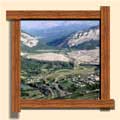 Heritage Community Foundation Presents
Heritage Community Foundation PresentsAlberta Online Encyclopedia
 |
|||
  |
|||
|
Home>> People and Communities>> Geographical Communities>> Regional Profiles>> Crowsnest Pass>> Frank |
|||
| Frank | |||
In 1900, Samual Gebo came to Alberta looking for coal. He
decided that an area south of the Canadian Pacific Railway (CPR)
and under the shadow of Turtle Mountain would be the ideal site
for a mining operation. Financed by Henry Frank, the two
entrepreneurs built the Canadian-American Coal and Coke Company,
and constructed a town named after the financer. The mine needed
workers and enterprising people from beyond the Pass responded
by travelling west to populate the growing town. By the time of
Frank’s formal opening party on 10 September 1901, the
population had expanded to 300. By 1903, it On 29 April 1903, the prosperity of the town changed in mere seconds. In less than two minutes, a rockslide covering three-square kilometres wiped out an operating plant, closed the mouth of the mine, and destroyed many of the houses in the town. Only fate determined which houses were spared and which occupants would survive. According to Monica Field and David McIntyre in their book On the Edge of Destruction:
The fear of another slide loomed over the community. When a 1911 Royal Commission report warned of a possible second rockslide, the community's worst fears were confirmed. While many decided to move their homes to the far side of Highway 3, others left the area completely, never to return. By 1912, the Canadian Consolidated Company liquidated their assets and closed the mine. The exodus continued, and by year's end, the original town site was abandoned.
|
|||
 |
|||
For more on coal mining in Western Canada, visit Peel’s Prairie Provinces.




